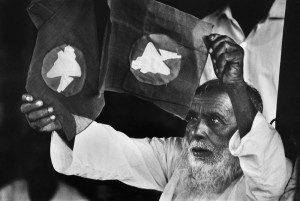Pathshala mourns the death of Sagar, a well loved teacher at the Multimedia Department of Pathshala South Asian Media Academy and his journalist wife Meherun Runi who were killed in mysterious circumstances on early Saturday morning the 11th February 2012. Sagar was the news editor of Masranga Television and?also worked with Deutsche Welle Bangla Service, Ittefaq, Jugantor and Sangbad. Runi was a senior reporter in ATN Bangla Television. While there are many speculations, it is not known why or who killed the journalist couple.?The exact time or the circumstances leading to their death has not been confirmed either.
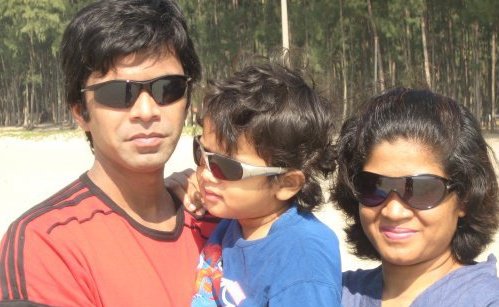
Mahi Sarwar Megh, their five year old son discovered the bodies of his parents in the morning and called his grandmother. Both had apparently been repeatedly stabbed in their??fourth-floor flat of a five storied building (58/A/2) in West Rajabazar.
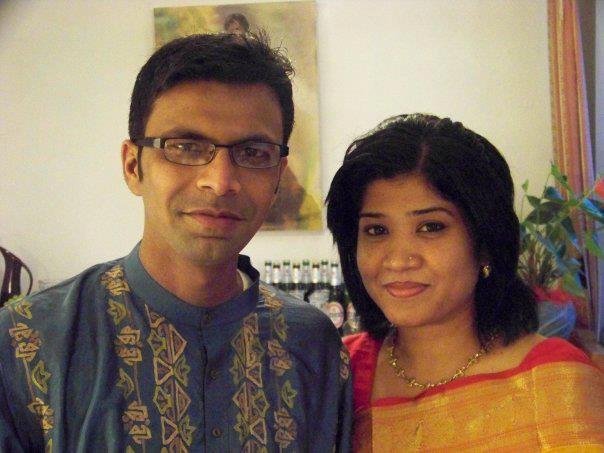
The first namaz-e-janaza of Sarwar and Runi was held at the?Dhaka?Reporters Unity office at Segunbagicha in the capital.
They couple will be buried later at Azimpur graveyard after two more namaz-e-janazas at Maasranga and ATN offices.

Category: Killings
Songs of a Wounded Image
(Editor’s introduction to “Birth Pangs of a Nation” produced to commemorate the 40th anniversary of the birth of Bangladesh and the 60 anniversary of the establishment of UNHCR.)
The Bangladeshi War of Liberation, like all other wars, has a contested history. The number killed, the number raped, the number displaced, are all figures that change depending upon who tells the story.
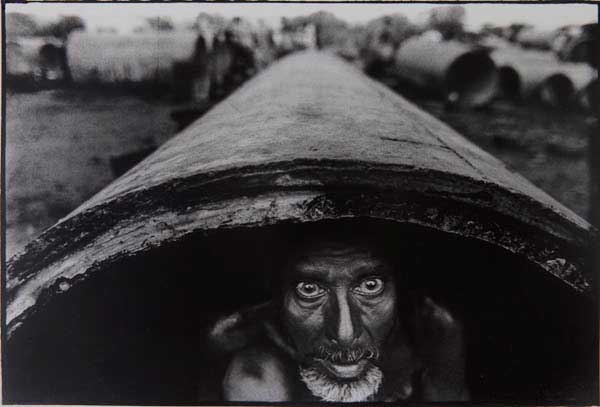
But in our attempt to be on the ?right side? of history, we often forget those who ended up on the wrong side. Those who have gone, those who were permanently scarred, mentally, physically, socially, don?t really care about our statistics. The eyes that stare into empty space, knowing not what they are searching, the frail legs, numbed by fatigue, drained by exhaustion, yet willed on by desperation, the wrinkled hands, seeking a familiar touch, a momentary shelter, longing for rest, do not care about the realpolitik of posturing superpowers.
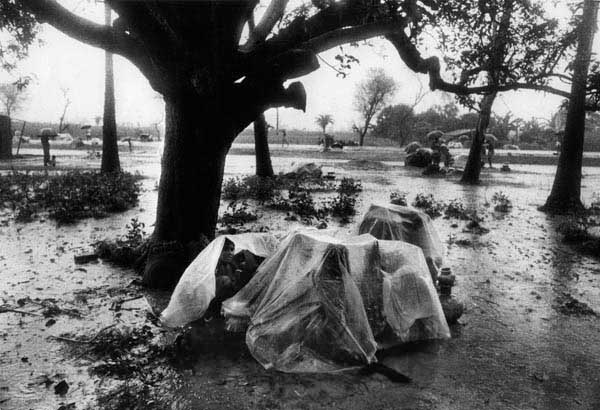
Is a 40th anniversary more than a convenient round number in a never-ending cycle of the displacement of the weak? Is a 60th anniversary more than a celebration of a milestone amongst many, where brave men and women have stood by those in need, but watched in silence as the perpetrators of injustice continued in their violent ways, leaving them to deal with the fallout?
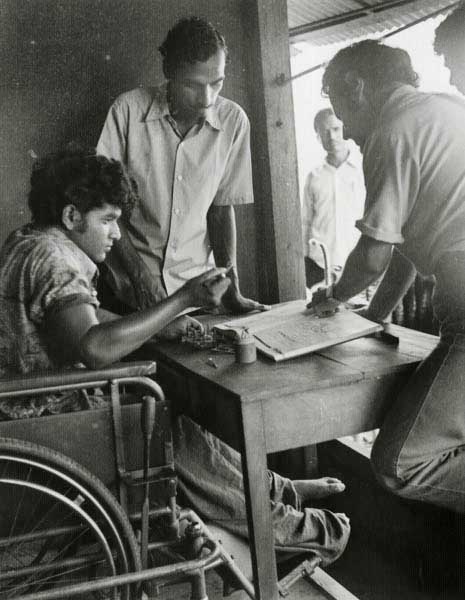
Continue reading “Songs of a Wounded Image”
If It Bleeds
“Weegee: Murder Is My Business” Through September 2.?International?Center of Photography, New York.
Weegee’s photographs are as much about Weegee as they are about crime.
By James Polchin

Weegee strikes again
Body of Dominick Didato, Elizabeth Street, New York, August 7, 1936.
In the fall of 1978, the International Center of Photography mounted the first retrospective of Weegee photographs. Reviews of the show were positive, though the reviews often centered on debates about the artfulness of Weegee?s tabloid images. The?New York Times?critic began with the very conundrum of this tension between art and news photography: ?It is always faintly alarming to see the photographs of Weegee on exhibition at a museum or gallery. They were not made for exhibition but to be reproduced in tabloid newspapers.? Despite this beginning, the review affirms Weegee?s importance in American photography, and argues that his work influenced later artists such as Diane Arbus and Garry Winograd. Continue reading “If It Bleeds”
We
We!
The children are reduced to bones
And skin. Their tiny bodies
Have heads appearing far too large
And eyes that cry for help.
But there’s no shortage yet of guns
And bullets — or of bombs.
And soon enough, you hear them come —
The jets that scream through skies
And drop the rain that’s so obscene
That voices then fall still.
******
The drones that fly like sightless birds,
The tanks that roll through streets,
The men who fire on passers by,
Who buys and pays these?
We!
****** Continue reading “We”
Selective Outrage
Media Lens, London, 18 January 2012
News that a fourth scientist in two years, Mostafa Ahmadi Roshan, had been assassinated in Iran by an unknown agency generated minimal outrage in the press.
Patrick Cockburn notedin the Independent:
?While the identity of those carrying out the assassinations remains a mystery, it is most likely to be Israel’s foreign intelligence service, Mossad??
The Sunday Times published a meticulous account of the planning and execution of the attack provided by ?a source who released details? on the actions of ?small groups of Israeli agents? operating inside Iran. (Marie Colvin and Uzi Mahnaimi, ?Israel’s secret war,? Sunday Times, January 15, 2012)
Julian Borger?s article in the Guardian warnedagainst ‘Goading a regime on the brink.’
We wonder if the Guardian would have described the Iranian assassination of scientists on US or Israeli streets as ?goading?. We also wonder if Borger would have described these as terrorist attacks. Continue reading “”
What really links the 'urinating marines' video with Abu Ghraib
In the digital age, people document and share everything ? even insults to the fallen
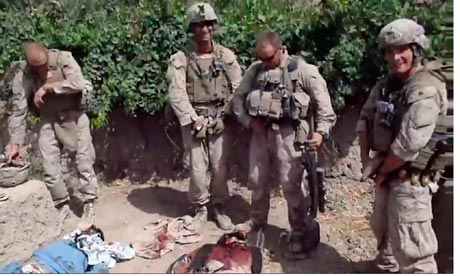
?Have a Nice Day, Buddy:? What The Actions of a Few US Marines Say About us All
?Jan 13 2012 by?Sherene Seikaly and Maya Mikdashi
![[Left: US Marines urinating on dead Afghans. Image from AFP. Right: Afghan civilian dead on the road. Image from unknown archive] [Left: US Marines urinating on dead Afghans. Image from AFP. Right: Afghan civilian dead on the road. Image from unknown archive]](http://www.jadaliyya.com/content_images/3/Screenshot2012-01-12at4.54.26PM.png)
Then as now, brown bodies are the raw material through and upon which US soldiers realize their darkest fantasies and their deepest secrets. The pornography that popularized the ?golden shower? and the Islamophobia that fuels the War on Terror inspire these scenes. In them, US soldiers feminize Muslim men and demonstrate their power over them. US soldiers can and will sodomize, piss on, and otherwise sexually humiliate Muslim and/or Arab men. And the world will witness this confident hierarchy of masculinity through the dissemination of the torturer?s documentation. Continue reading “?Have a Nice Day, Buddy:? What The Actions of a Few US Marines Say About us All”
West Bank 2011: One year of Humiliation in a Two Minutes Video
It is a new year in the West Bank
And on Christmas, a rainy and great wind swept over the West Bank and East Jerusalem. Trees bent and roofs rattled but the wind couldn?t carry away the suffering, vulnerability and the long 365 days of humiliation.
 Israeli border soldier stands guard during repeated clashes with Palestinian demonstrators in the West Bank town of Qalandia in 2011
Israeli border soldier stands guard during repeated clashes with Palestinian demonstrators in the West Bank town of Qalandia in 2011
 IN the so called Middle East?s only democracy, they do not do guillotines. But there are other innovative rituals of humiliation, designed to reassure the Palestinians that every New Year could well be their last in the land of their ancestors, .. the land of olive trees. As the wind calms down everything returns to normal, but not for the Palestinians, they don?t. Continue reading “West Bank 2011: One year of Humiliation in a Two Minutes Video”
IN the so called Middle East?s only democracy, they do not do guillotines. But there are other innovative rituals of humiliation, designed to reassure the Palestinians that every New Year could well be their last in the land of their ancestors, .. the land of olive trees. As the wind calms down everything returns to normal, but not for the Palestinians, they don?t. Continue reading “West Bank 2011: One year of Humiliation in a Two Minutes Video”
Not for art's sake

Abstract of keynote presentation given at National University of Taiwan
8th January 2012. Taipei
Subscribe to ShahidulNews
One of the videos presented. A compilation from several videos on major protests in 2011
Long before CSR had become a buzzword and superstars and corporates began to find it essential to have pet social causes to support, we had set up Drik, a small organisation in Bangladesh, which made social justice its raison d’?tre.
Over two decades later, when my show on extra judicial killings at the gallery of Drik, was interpreted by a group of international curators as a ?fantastic performance?. It was time for me to take stock, and see where the art world situated itself and whether I belonged to this marketplace.
As collective movements go, the sub-continent has had its share. Colonial rule, oppression by the landed gentry, women?s struggle for equality in a patriarchal society and the injustice of caste have all been challenged. The solidarity of sustained groups, often against overwhelmingly stronger entities with far greater resources. had been a trademark for undivided India and for Bengal in particular.
It was the dynamics of a ruling class propped up by local agents who stood to profit from inequality, that led to the Gandhian strategy of non-violent resistance. Other methods had also been tried, and Subhas Chandra Bose, with a much more militant outlook, also had a huge following. The Tebhaga peasant movement by the Kisan Sabha had led to laws being formulated that limited the share of the landlords.
Partition did not cure these ills. The ouster of the British did not break up the class structure, but replaced one set of exploiters with another. The British, and other imperial powers continued to maintain unequal trade relations, sometimes in the guise of aid.
Cultural activists in Bangladesh had operated within this milieu. With the military under the control of the West wing, the more populous East Pakistan felt the weight of oppression. Military rule became the vehicle for continued repression but failed to quell the unrest and even the final genocidal attack on the people of East Pakistan, was repulsed by a countrywide resistance.
An independent Bangladesh, free of foreign occupiers, should have been a land free of repression. The reality was very different and cultural activists have had to find new ways of resistance. This has required documentation, articulation and tools of creative expression to deal with injustice in many forms. Having been failed by the major political parties (both government and opposition), cultural actors formed their own groups. Operating with minimum resources, we devised numerous initiatives to mobilise public opinion. Using both new and traditional media, as well as the networking ability of social media we formed lean and tenacious campaigns that chipped away at the establishment and its cohorts insisting on being heard and bent on achieving justice.
But the corporatization of modern Bangladesh has brought about many changes. I remember as a child that we used to respond to natural disasters by grouping together, singing songs, raising money, collecting food and old clothes and going out to affected areas to distribute them. We now leave such activities to the NGOs. Social movements are now sponsored by multinationals and protesters in rallies have sunshades parading the brand logos of telecom companies.
We had simultaneously taken on the hegemony of the west and its new southern accomplices, as well as the repressive regimes that operated within the nation state. But today we also need to examine how social movements have been appropriated, and our inability to operate without ?funding? regardless of the cause seriously limits our capacity for social and political intervention.
As an artist, as an activist, and as an organizer, I have along with my colleagues taken on technology, art, education and culture in its diverse forms and have presented a cohesive front that has challenged the military, major political parties and corporates, while continuing to operate independently within public and private spheres.
The presentation attempts to show how, by resisting not only the formal entities that have usurped power, but also the cultural norms that attempt to pigeon-hole cultural practice in terms of ?fine art?, I as an individual artist, as well as worker in a commune, have tried to ensure that our ?art? does not limit itself to admiration in a gallery. It breathes the gunpowder laden air of street battles with police, the dank vapours of the factory floor and pervades the silence of patriarchal inner chambers.
Shahidul Alam
8th January 2012
Taipei
American Activists and the Birth of Bangladesh
Subscribe to ShahidulNews
Play in New Window |?Download
Forty years ago this month, the country of Bangladesh declared its independence from Pakistan. Then-President Richard Nixon supported Pakistan during the war because he wanted to prove the US would stand by an ally.
Many Americans disagreed with that stance. And when a ship headed for Pakistan with military equipment and ammunition was set to stop at a US port, one group of Americans felt it was necessary to get involved.
?I was ready to risk my life there,? says 78-year-old Richard Taylor. ?I just wanted to get in front of that ship.? Continue reading “American Activists and the Birth of Bangladesh”


